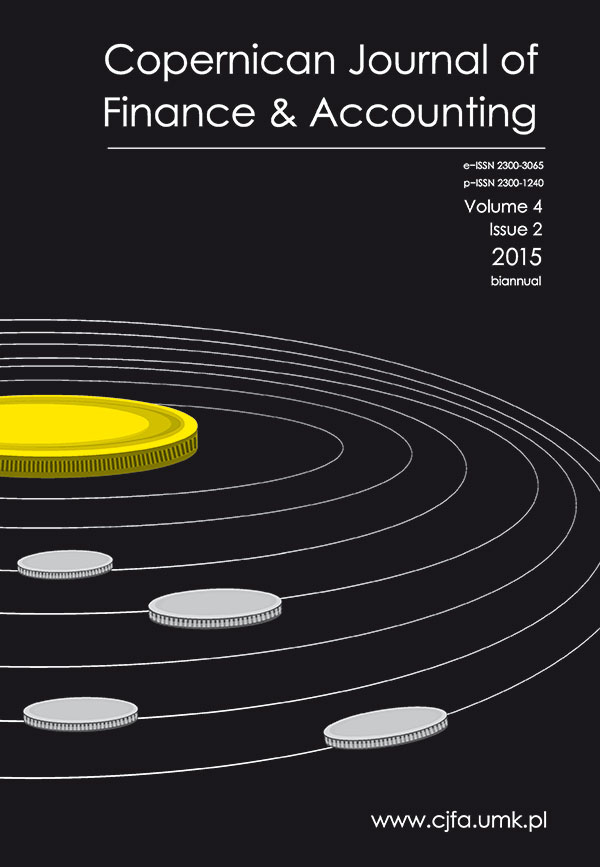Forecasting the Jordanian stock index: modelling asymmetric volatility and distribution effects within a GARCH framework
DOI :
https://doi.org/10.12775/CJFA.2015.013Mots-clés
GARCH, asymmetry, distributionsRésumé
The modelling of market returns can be especially problematical in emerging and frontier financial markets given the propensity of their returns to exhibit significant non-normality and volatility asymmetries. This paper attempts to identify which representations within the GARCH family of models can most efficiently deal with these issues. A number of different distributions (normal, Student t, GED and skewed Student) and different volatility of returns asymmetry representations (EGARCH and GJR- -GARCH) are examined. Our data set consists of daily Jordanian stock market returns over the period January 2000 – November 2014. Using both the Superior Predicative Ability (SPA) and Model Confidence Set (MCS) testing frameworks it is found that using GJR-GARCH with a skewed Student distribution most accurately and efficiently forecasts Jordanian market movements. Our findings are consistent with similar research undertaken in respect to developed markets.
Références
Al-Hajieh, H., Redhead, K., & Rodgers T. (2011). Investor sentiment and calendar anomaly effects: A case study of the impact of Ramadan on Islamic Middle Eastern markets. Research in International Business and Finance, 25 (3), 345-356. http://dx.doi. org/10.1016/j.ribaf.2011.03.004.
Andrikopoulos, P., Niklewski, J., & Rodgers T. (forthcoming). The portfolio diversification benefits of frontier markets: an investigation into regional effects. Handbook of Frontier Markets. Ed. by Andrikopoulos P., Gregoriou G., and Kallinterakis V. Elsevier.
Assaf, A. (2015). Value-at-Risk analysis in the MENA equity markets: Fat tails and conditional asymmetries in return distributions. Journal of Multinational Financial Management, 29, 30-45. http://dx.doi.org/10.1016/j.mulfin.2014.11.002.
Awartani, B. M., & Corradi, V. (2005). Predicting the volatility of the S&P-500 stock index via GARCH models: the role of asymmetries. International Journal of Forecasting, 21 (1), 167-183. http://dx.doi.org/10.1016/j.ijforecast.2004.08.003.
Balaban, E. (2004). Comparative forecasting performance of symmetric and asymmetric conditional volatility models of an exchange rate. Economics Letters, 83 (1), 99– –105. http://dx.doi.org/10.1016/j.econlet.2003.09.028.
Bentes, S. R., Menezes, R., & Ferreira, N. B. (2013). On the asymmetric behaviour of stock market volatility: evidence from three countries. International Journal of Academic Research, 5 (4), 24-32. http://dx.doi.org/10.7813/2075-4124.2013/5-4/A.4.
Bollerslev, T. (1986). Generalized autoregressive conditional heteroskedasticity. Journal of econometrics, 31 (3), 307-327. http://dx.doi.org/10.1016/0304-4076(86)90063-1.
Brailsford, T. J., & Faff, R. W. (1996). An evaluation of volatility forecasting techniques. Journal of Banking & Finance, 20 (3), 419-438. http://dx.doi.org/10.1016/0378- 4266(95)00015-1.
Brooks, R. (2007). Power arch modelling of the volatility of emerging equity markets. Emerging Markets Review, 8(2), 124-133. http://dx.doi.org/10.1016/j.ememar. 2007.01.002.
Engle, R. F. (1982). Autoregressive conditional heteroscedasticity with estimates of the variance of United Kingdom inflation. Econometrica: Journal of the Econometric Society, 50 (4), 987-1007. http://dx.doi.org/10.2307/1912773.
Engle, R. F., & Ng, V. K. (1993). Measuring and testing the impact of news on volatility. The journal of finance, 48(5), 1749-1778. http://dx.doi.org/10.1111/j.1540-6261.1993. tb05127.x.
Fernández, C., & Steel, M. F. (1998). On Bayesian modeling of fat tails and skewness. Journal of the American Statistical Association, 93(441), 359-371. http://dx.doi.org /10.1080/01621459.1998.10474117.
Glosten, L. R., Jagannathan, R., & Runkle, D. E. (1993). On the relation between the expected value and the volatility of the nominal excess return on stocks. The journal of finance, 48 (5), 1779-1801. http://dx.doi.org/10.1111/j.1540-6261.1993.tb05128.x.
Gokcan, S. (2000). Forecasting volatility of emerging stock markets: linear versus non‐linear GARCH models. Journal of Forecasting, 19 (6), 499-504. http://dx.doi. org/10.1002/1099-131X(200011)19:6%3C499::AID-FOR745%3E3.0.CO;2-P.
Hansen, P. R. (2005). A test for superior predictive ability. Journal of Business & Economic Statistics, 23 (4), 365-380. http://dx.doi.org/10.1198/073500105000000063.
Hansen, P. R., & Lunde, A. (2005). A forecast comparison of volatility models: does anything beat a GARCH (1, 1)?. Journal of applied econometrics, 20 (7), 873-889. http:// dx.doi.org/10.1002/jae.800.
Hansen, P. R., & Lunde, A. (2014). MULCOM 3.00. Econometric toolkit for multiple comparisons. Unpublished working paper.
Hansen, P. R., Lunde, A., & Nason, J. M. (2011). The model confidence set. Econometrica, 79 (2), 453-497. http://dx.doi.org/10.3982/ECTA5771.
Heynen, R. C., & Kat, H. M. (1994). Volatility prediction: a comparison of the stochastic volatility, Garch (1, 1) and Egarch (1, 1) models. The Journal of Derivatives, 2 (2), 50– –65. http://dx.doi.org/10.3905/jod.1994.407912.
Liu, H. C., & Hung, J. C. (2010). Forecasting S&P-100 stock index volatility: The role of volatility asymmetry and distributional assumption in GARCH models. Expert Systems with Applications, 37 (7), 4928-4934. http://dx.doi.org/10.1016/j.eswa.2009.12.022.
Marcucci, J. (2005). Forecasting stock market volatility with regime-switching GARCH models. Studies in Nonlinear Dynamics & Econometrics, 9(4), 1-53. http://dx.doi. org/10.2202/1558-3708.1145.
McMillan, D., Speight, A., & Apgwilym, O. (2000). Forecasting UK stock market volatility. Applied Financial Economics, 10(4), 435-448. http://dx.doi.org/10.1080/ 09603100050031561.
Mittnik, S., Paolella, M. S., & Rachev, S. T. (2000). Diagnosing and treating the fat tails in financial returns data. Journal of Empirical Finance, 7 (3), 389-416. http://dx.doi. org/10.1016/S0927-5398(00)00019-0.
Nelson, D. B. (1991). Conditional heteroskedasticity in asset returns: A new approach. Econometrica: Journal of the Econometric Society, 59(2), 347-370. http:// dx.doi.org/10.2307/2938260.
Téléchargements
Publié-e
Comment citer
Numéro
Rubrique
Stats
Number of views and downloads: 620
Number of citations: 0



